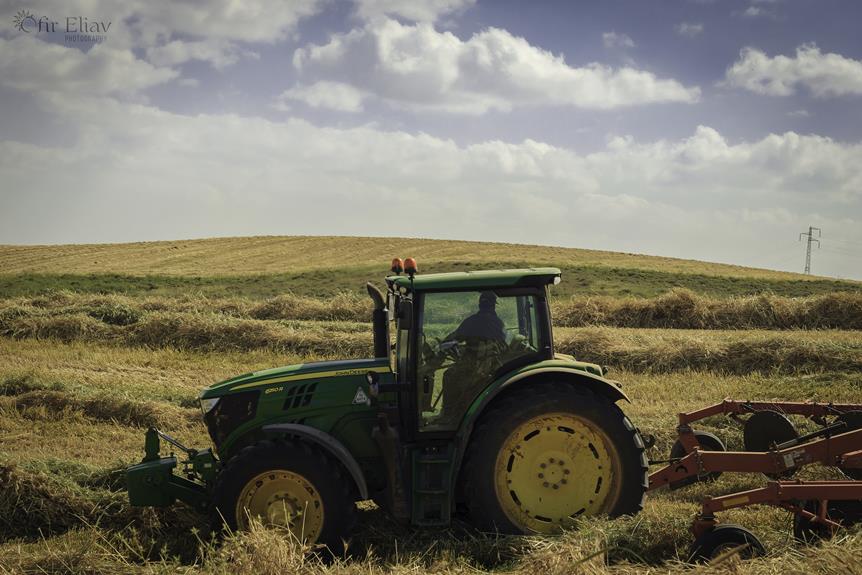Agricultural Vehicle Tires: Choosing the Right Fit
In the realm of agricultural vehicle tires, finding the perfect fit is paramount. This comprehensive guide aims to assist you in making informed decisions when selecting tires for your agricultural vehicles.
By delving into the factors to consider, such as tire size, tread patterns, and soil type, we empower you to optimize your farming operations.
Additionally, we provide expert tips for maintaining and extending the lifespan of your agricultural tires.
Explore this article to ensure your vehicles experience the freedom they deserve on the fields.
Key Takeaways
- Proper tire maintenance is crucial for durability and longevity.
- Soil conditions, load capacity, and tread design are important factors to consider when selecting agricultural tires.
- Accurate tire sizing is essential for optimal performance and fuel efficiency.
- Regular inspections, tire rotations, and specialized tire compounds can extend the lifespan of agricultural tires.
Understanding Your Agricultural Vehicle's Tire Needs
One key factor in understanding your agricultural vehicle's tire needs is determining the appropriate number of tires required for optimal performance and efficiency. Agricultural tire durability and the benefits of proper tire maintenance play a crucial role in this decision-making process.
When considering the number of tires needed for your agricultural vehicle, it is important to consider the weight distribution and load capacity. Agricultural vehicles often carry heavy loads, and insufficient tire capacity can lead to premature wear and reduced performance. By ensuring that your vehicle has the correct number of tires, you can distribute the weight evenly and maximize the load capacity.
Proper tire maintenance is essential for agricultural vehicles to ensure durability and longevity. Regular inspections and maintenance routines, such as checking for tire pressure, tread wear, and any signs of damage, are necessary to prevent tire failure. Implementing a tire rotation schedule can also help distribute wear evenly and extend the lifespan of the tires.
The benefits of proper tire maintenance are numerous. By maintaining optimal tire pressure, you can improve fuel efficiency and reduce overall operating costs. Additionally, well-maintained tires provide better traction, resulting in improved performance and increased safety.
Factors to Consider When Selecting Agricultural Tires
When selecting agricultural tires, it is crucial to consider factors such as soil conditions, load capacity, and tread design to ensure optimal performance and productivity in farming operations. Tire durability is a key consideration, as agricultural vehicles often operate in challenging environments and are subject to heavy loads. Additionally, cost considerations play a significant role in the decision-making process.
To illustrate the importance of these factors, let's consider a comparison table of two popular agricultural tire options: Tire A and Tire B.
| Factors | Tire A | Tire B |
|---|---|---|
| Soil Conditions | Suitable for all soils | Best for loose soil |
| Load Capacity | 3,000 lbs | 2,500 lbs |
| Tread Design | Deep grooves | All-terrain tread |
| Durability | High | Moderate |
| Cost | $250 | $200 |
As seen in the table, Tire A is suitable for all types of soil conditions, while Tire B performs best in loose soil. Tire A also has a higher load capacity of 3,000 lbs compared to Tire B's 2,500 lbs. The tread design differs as well, with Tire A having deep grooves for improved traction, while Tire B features an all-terrain tread. In terms of durability, Tire A is considered high, whereas Tire B is moderate. However, it is important to note that Tire B is more cost-effective at $200 compared to Tire A's $250.
Determining the Right Tire Size for Your Agricultural Vehicle
Determining the right tire size for your agricultural vehicle is crucial for optimal performance and productivity. The size of the tire directly affects various factors such as traction, load-carrying capacity, and fuel efficiency.
Factors that influence tire size include the vehicle's weight, axle configuration, terrain conditions, and intended use.
Importance of Accurate Sizing
Ensuring accurate sizing is crucial in selecting the right tire for your agricultural vehicle, as it directly impacts the vehicle's performance and overall productivity.
Proper sizing ensures optimal traction, load-carrying capacity, and stability, allowing the vehicle to operate efficiently in various terrains and conditions. An undersized tire may result in reduced traction and increased slippage, while an oversized tire can cause excessive wear and tear on the vehicle's components.
Additionally, improper tire sizing can affect the vehicle's fuel efficiency and maneuverability. It is also important to consider the importance of proper inflation and the benefits of specialized tire compounds.
Proper inflation ensures optimal tire performance, including improved traction, reduced rolling resistance, and extended tire life. Specialized tire compounds offer enhanced durability, puncture resistance, and increased grip, allowing agricultural vehicles to operate effectively in challenging environments.
Factors Influencing Tire Size
Taking into account various factors such as vehicle weight, load requirements, and terrain conditions, selecting the appropriate tire size for agricultural vehicles is crucial for optimal performance. The influence of weather on tire performance cannot be overlooked, as different weather conditions can have a significant impact on vehicle performance. For instance, in wet and muddy conditions, having larger tires with deep treads can provide better traction and prevent slippage. In contrast, for dry and hard-packed soil, smaller tires with less aggressive treads can improve fuel efficiency and reduce soil compaction. Furthermore, the load requirements of the vehicle should also be considered when choosing tire size, as heavier loads may require larger tires to distribute the weight evenly. Overall, understanding the various factors influencing tire size is essential to ensure efficient and effective agricultural operations.
Transitioning into the next section, exploring different tread patterns for agricultural tires will further enhance the performance and versatility of these vehicles.
Exploring Different Tread Patterns for Agricultural Tires
Our team is currently evaluating various tread patterns for agricultural tires to determine the most effective option for enhancing traction and minimizing soil compaction. Traction control in agricultural tire design is crucial as it directly impacts the performance and efficiency of farming equipment. The right tread pattern can significantly improve traction, allowing vehicles to navigate challenging terrains with ease. Additionally, it can also help minimize soil compaction, which is essential for maintaining the health and productivity of the soil.
Furthermore, the impact of weather conditions on agricultural tire performance cannot be overlooked. Different weather conditions, such as rain, snow, or extreme heat, can affect the grip and traction of tires. Therefore, it is crucial to consider these factors when selecting the appropriate tread pattern for agricultural tires.
Moving forward, it is important to note that the choice of agricultural vehicle tires should also take into account the soil type. Different soils have varying levels of compaction, texture, and moisture retention capabilities. Therefore, understanding the soil type is essential in determining the most suitable tread pattern for agricultural tires.
The Importance of Soil Type in Choosing Agricultural Vehicle Tires
The selection of agricultural vehicle tires should consider the soil type, as it plays a crucial role in determining the optimal tread pattern for maximizing traction and minimizing soil compaction. Soil composition varies greatly across different regions, and understanding its characteristics is essential for farmers and agricultural vehicle manufacturers alike.
When choosing agricultural vehicle tires, here are three key factors to consider:
- Soil Type: Different soils have different levels of cohesion, moisture content, and compaction resistance. Sandy soils require tires with a more aggressive tread pattern to provide sufficient traction, while clayey soils benefit from tires with deeper treads to prevent slippage.
- Tire Pressure: Proper tire pressure is crucial for optimal performance and minimizing soil compaction. Overinflated tires can lead to excessive soil disturbance and compaction, while underinflated tires may not provide enough traction. Maintaining the recommended tire pressure ensures the tires distribute weight evenly and reduce soil damage.
- Soil Composition: The composition of the soil, including its organic matter content and nutrient levels, can impact tire selection. Soils with high organic matter content tend to be softer and require tires with larger surface areas to prevent sinking. Additionally, knowing the soil's nutrient content can help determine if special tire materials or coatings are needed to prevent corrosion.
Tips for Maintaining and Extending the Lifespan of Your Agricultural Tires
Regularly inspecting and maintaining your agricultural tires is crucial for maximizing their lifespan and ensuring optimal performance in the field. One important aspect of tire maintenance is proper inflation. It is essential to check the tire pressure regularly and adjust it according to the manufacturer's recommendations. Underinflated tires can lead to decreased fuel efficiency, reduced load-carrying capacity, and increased risk of tire failure. On the other hand, overinflated tires can cause a harsh ride, decreased traction, and increased wear on the center of the tire.
Another important maintenance practice is tire rotation. By periodically rotating the tires, you can ensure even wear across all tires. This is especially important for agricultural vehicles that often operate in challenging terrain. Uneven wear can lead to reduced traction, decreased fuel efficiency, and even tire failure. Rotating the tires allows for a more balanced distribution of wear and extends the overall lifespan of the tires.
In addition to proper inflation and tire rotation, it is also important to regularly inspect the tires for any signs of damage or wear. This includes checking for cuts, bulges, uneven wear patterns, or any other abnormalities. Promptly addressing any issues can prevent further damage and ensure the continued performance and safety of your agricultural tires.
Frequently Asked Questions
How Do I Know if My Agricultural Vehicle Needs New Tires?
Determining if your agricultural vehicle needs new tires can be done by inspecting for signs of wear, such as tread depth, cracking, or bulges. It is important to replace tires when they no longer meet safety standards or affect performance.
Can I Use the Same Tires for Different Types of Agricultural Vehicles?
Tire compatibility and the use of interchangeable tires for different types of agricultural vehicles is a common concern. It is important to consider factors such as load capacity, traction requirements, and tire size when determining if the same tires can be used.
Are There Any Regulations or Standards That I Should Consider When Choosing Agricultural Vehicle Tires?
When choosing agricultural vehicle tires, it is important to consider any regulations or standards that may apply. These regulations ensure that the tires meet certain performance standards and that proper tire maintenance is followed. Additionally, tire performance testing can help determine the best fit for your specific agricultural vehicle.
What Are the Benefits of Using Radial Tires Versus Bias-Ply Tires for Agricultural Vehicles?
Radial tires offer several advantages over bias-ply tires for agricultural vehicles. They provide better traction, improved fuel efficiency, and longer tread life. However, they are typically more expensive and can have lower puncture resistance.
How Often Should I Check the Tire Pressure on My Agricultural Vehicle?
Checking tire pressure regularly is of utmost importance for proper tire maintenance on agricultural vehicles. Neglecting this task can lead to decreased fuel efficiency, reduced traction, and increased risk of tire failure.
Conclusion
In conclusion, selecting the right agricultural vehicle tires is crucial for optimal performance and efficiency. Factors such as tire size, tread patterns, and soil type must be carefully considered.
Regular maintenance and proper care can help extend the lifespan of these tires. By understanding the specific needs of your agricultural vehicle and choosing the appropriate tires, you can ensure smooth operations and maximize productivity on the field.
Remember, the right fit is essential for a successful harvest.







